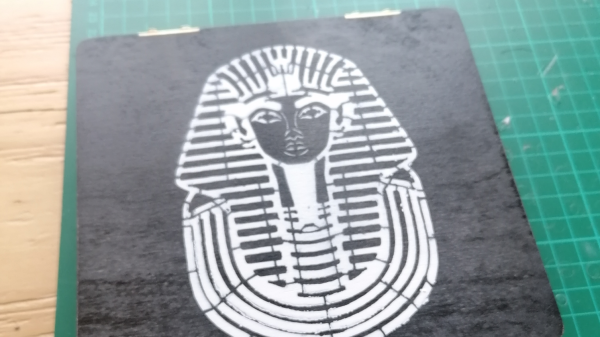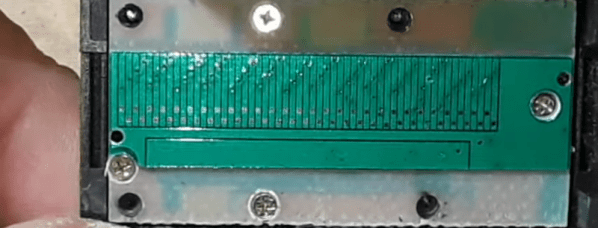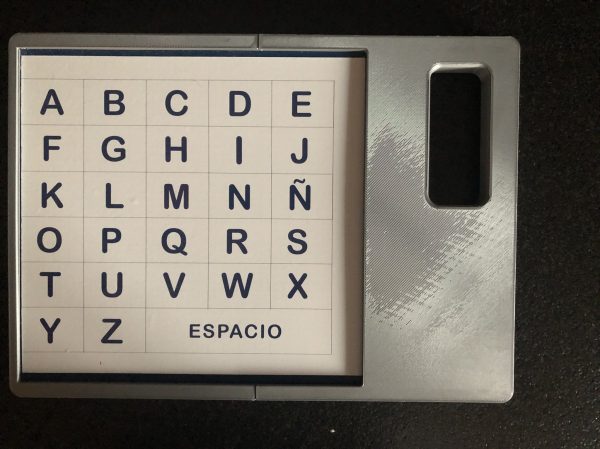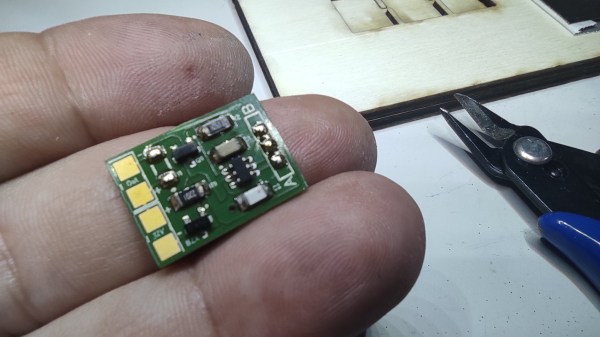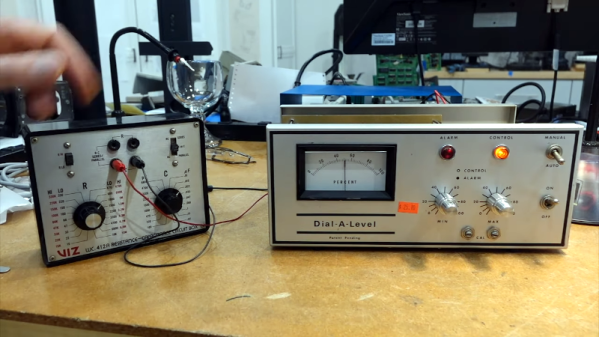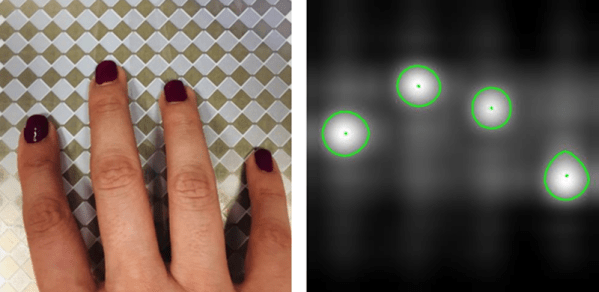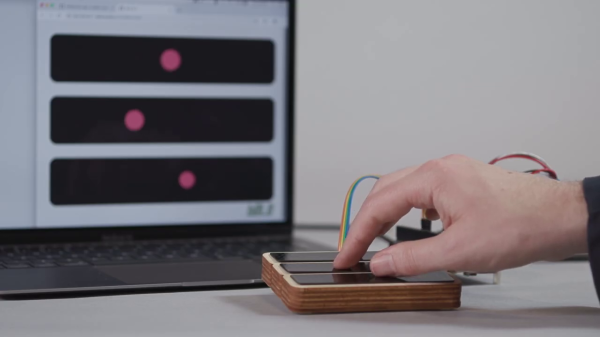[James Stanley] likes to spend time making puzzles and gadgets for escape rooms, and decided for a change to try their hand at a bit of magic. The idea was to construct a ‘magic box’, in which a coin can be placed in one of a number of slots, and then be able to remotely be able to determine the slot by means unseen. Obviously, this is an electronics hack, with a neat package of sensor and radio comms hidden inside a stack of CNC-milled wood. Coin locations are transmitted via Bluetooth to a Bangle.js smartwatch, which vibrates according to the slot occupied, allowing [James] to predict where the coin was placed. Continue reading “The Egyptian Coin Box ‘Trick’”
capacitive sensing17 Articles
Inside Digital Calipers
If you do any kind of machining, 3D printing, or PCB layout, you probably have at least considered buying a pair of calipers. Old-fashioned ones had a dial and were mechanical devices, but lately, digital ones have become quite affordable. We keep meaning to tear a set of ours apart to see what’s inside, but thanks to [learnelectronics], we don’t have to — the video below provides a fascinating look at what’s inside a cheap pair of Harbor Freight calipers.
Honestly, it doesn’t seem like it would be that hard to figure out how far down a bar you are. The trick is the caliper has to be super accurate. Oddly enough, the cheap calipers examined use capacitors as a sensing element.
There is a long flexible PCB stuck to the sliding part with conductive pads. The display unit is also a printed circuit and manages the battery, the display, and the other half of the capacitive sensor. If you want a more detailed explanation of how the sensor actually works, check out capsense.com. If you note, the pattern on the sliding part has traces that look like a square wave, and half have a different phase than the other half. These are the sine plates and the cosine plates. A 100 kHz signal flows through the capacitor, and it is possible to read the direction of travel and the amount of travel easily.
The calipers are very accurate, but it’s possible to improve them. A more practical project is to make them communicate with the outside world.
Hackaday Prize 2023: Bluetooth Spell To Speak
Have you ever known what you wanted to say but couldn’t figure out exactly how to say it? For some individuals, that’s all the time. The gap between intention and action can be a massive chasm. [Pedro Martin] is trying to help bridge that gap with a Bluetooth RPM letterboard.
[Soma Mukhopadhyay] developed Rapid Prompting Method (RPM) for teachers to work with students with autism. Gentle physical cues can help individuals complete motor movements, which can be used as a communication mechanism by pointing to a letterboard. Students can eventually move onto an tablet, but some students see the light as sensory noise or might associate it with playtime.
[Pedro] hopes that his letterboard will be able to provide tactile feedback for each letter to strengthen the connection the teacher is trying to establish. The letter board is a 22 by 14 grid (308 total) of touch electrodes connected to three MPR121 12-channel capacitive touch sensors connected to an ESP32 via I2C. Additionally, 60 LEDS controlled by two shift registers are interspaced between the touch electrodes. As only one LED will be on at a given time, [Pedro] can use the shift registers in a row/column setup since the current draw should be small. A piezo buzzer serves as additional feedback for the student. The ESP32 emulates a Bluetooth keyboard, so the teacher doesn’t have to keep track of what the student is spelling and can focus on RPM.
[Pedro] encountered the usual slew of debugging problems, such as ground bouncing, captive noise, and Bluetooth wonkiness. The code, KiCad, and STL files are on the Hackaday.io project page. If you want more accessibility-focused keyboards, look at the RP2040-based Intellikeys we saw recently.
Continue reading “Hackaday Prize 2023: Bluetooth Spell To Speak”
TTP223 Brings Simple Touch Controls To A LED Lamp
You can buy small modules with capacitive touch detection ICs — most often it’s the TTP223, a single-button capacitive model with configurable output modes. These are designed to pair with a microcontroller or some simple logic-level input, but [Alain Mauer] wanted was to bring touch control to a simple LED strip. Not to be set deterred, he’s put together a simple TTP223-based switch board.
Initially, he made a prototype using one of the regular TTP223 boards as a module, but then transferred the full schematic onto a single PCB. The final board uses an NPN transistor capable of handling up to 3 amps to do the switching job, and Zener-based regulation to provide 5 V for the TTP223 itself from the 12 V input. [Alain] shares the schematic, as well as BOM together with Gerber files for a 2×3 panel in case you’re interested in adding a few of these handy boards to your parts bin.
The TTP223 is a ubiquitous and quite capable chip – we’ve seen it used for building a mouse with low actuation force buttons, a soft power switch, and even a UV-sensing talisman that’s equal parts miniature electronics and fascinating metalwork.
Continue reading “TTP223 Brings Simple Touch Controls To A LED Lamp”
Mystery Box Gives Up Its Patented Secrets
[CuriousMarc] likes to go to surplus stores even though there are fewer of them around. On a recent trip, he found a box that had some parts he thought would work for a temperature controller project. It was marked Dial-A-Level and proudly proclaimed that it had a patent pending. The box was from the 1970s and [Marc] was wondering what the device was meant to do.
The device was a bit of a puzzle since it had three oddly-marked probe inputs. A search through the patent database revealed the device was a “capacitance probe for detecting moisture with very long cables.” The idea was to create a capacitor at the end of the cable and use the liquid as a dielectric. The sensor creates a 10 kHz sine wave it uses to excite the probe and an op amp measures the relative capacitive reactance of the probe versus a reference capacitor. The rest of the circuit is a comparator that reacts when the level is at a threshold.
We love seeing the old hand-drawn boards from that era. Component designations are in copper and there’s no solder mask visible. There was a clever application of a silicon controlled rectifiers and a relay to create a type of flip flop, that [Marc] explains.
Interestingly, the company that made the device, Expo Instruments, is still around and [Marc] contacted them. The actual patent holder replied and was amazed that [Marc] had possession of this antique. You can only wonder if anything you build today will wind up on whatever passes for YouTube three or four decades from now.
Capacitive sensing is quite versatile. Of course, there are many other ways to sense liquid level, too.
Continue reading “Mystery Box Gives Up Its Patented Secrets”
Arduino Does Multitouch
A lot of consumer gadgets use touch sensors now. It is a cheap and reliable way to replace a variety of knobs and switches on everything from headphones to automobiles. However, creating a custom touch controller for a one-off project can be daunting. A recent ACM paper shows how just about any capacitive sensor can work as a multitouch sensor with nothing more than an Arduino although a PC running processing interprets the data for higher-level functions.
The key is that the Arduino excites the grid using PWM and then examines the signal coming out of the grid. Finger poking changes the response quite a bit and the Arduino can sense it using the analog to digital converters onboard. You can find the actual software kit online. The tutorial document is probably more interesting than the ACM paper if you only want to use the kit.
The optimum drive frequency is 10 MHz. The examples rely on harmonics of a lower frequency PWM signal to get there. The analog conversion, of course, isn’t that fast but since your finger touch rate is relatively slow, they treat the signal as an amplitude-modulated input which is very easy to decode.
The sensors can be conductive ink, thread, or copper strips. There are several example applications, including a 3D printed bunny you can pet, a control panel on a sleeve, and an interactive greeting card.
The sensor forms an image and OpenCV detects the actual touch configuration. It appears you can use the raw data from the Arduino, too, but it might be a little harder.
We imagine aluminum foil would work with this technique. If you get to the point of laying out a PCB, this might come in handy.
Trill: Easy Positional Touch Sensors For Your Projects
Creating capacitive touch-sensitive buttons is easy these days; many microcontrollers have cap-sense hardware built-in. This will work for simple on/off control, but what if you want a linear, position-sensitive input, like you’d find on a computer touchpad or your smartphone screen? Not so easy — at least until now. Trill is a family of capacitive touch sensors you can add to your projects as a linear slider, a square touchpad, or by creating your own touch surface.
Trill was created by the same team that designed Bela, an embedded platform for low-latency interactive applications, especially with audio. The new trio of Trill sensors rely on capacitive sensing to track finger movement, and communicate over I2C with your microcontroller or development board of choice. The Trill I2C library targets Arduino and Bela, but should be easy to port to any I2C host.
The hardware and software are both open-source — or will be as the Kickstarter that launched this morning has already met its goal. The firmware for the Cypress CY8C20636A (PDF) controller that powers these sensors will be released CC-BY-NC-SA. But, starting with the controller itself sounds like a lot of work that Trill has already done for you, so let’s have a look at what we know so far, along with a healthy dose of speculation.
Continue reading “Trill: Easy Positional Touch Sensors For Your Projects”

